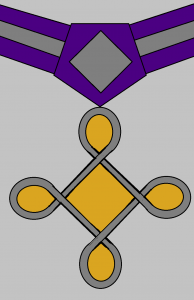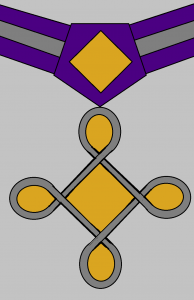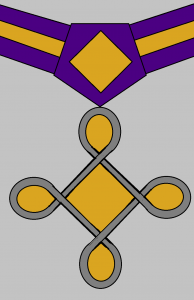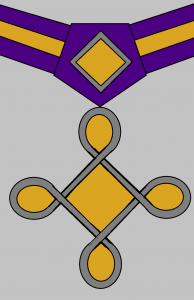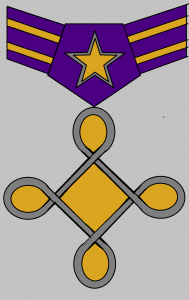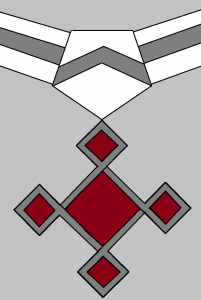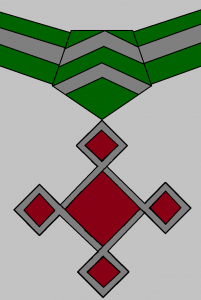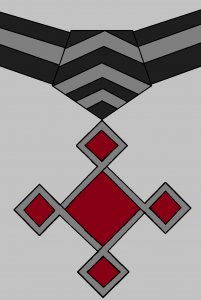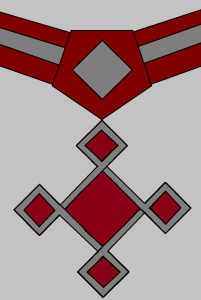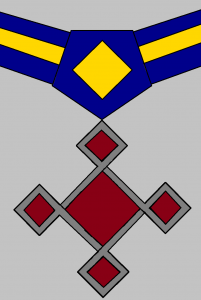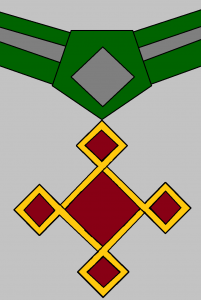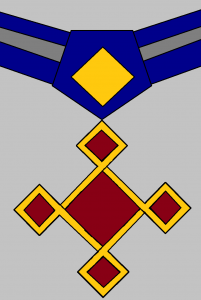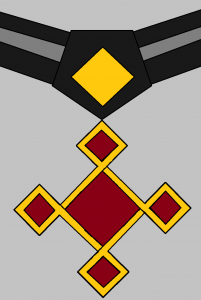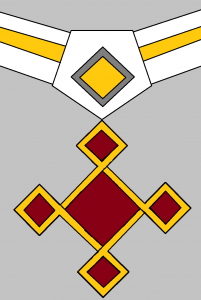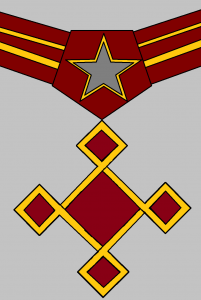The Imperial Commonwealth has two orders of merit. The Commonwealth Cross is a civilian award, given to diplomats, industrialist and other notable individuals. The Imperial Cross is a military award, given to officers and enlisted personnel of the forces.
In each case, the cross itself hands from a five-sided shield, suspended from the neck by a ribbon. The color of the ribbon depends on individual receiving it. A civilian’s ribbon is purple, while the military ribbon’s color is dependent on what branch of service it was awarded from. This is known as the ribbon’s banner (for example, an award for excellence in a naval role would put the award as ‘of the Blue Banner’).
| Black | Imperial Cross | Scouts / Intelligence |
| Blue | Imperial Cross | Navy ships |
| Green | Imperial Cross | Logistics and Support |
| Purple | Commonwealth Cross | Civilian |
| Red | Imperial Cross | Land Combat Arms |
| White | Imperial Cross | Air Force |
Commonwealth Cross
The Commonwealth Cross is the civilian order of merit. It consists of a purple ribbon with a silver and gold rounded Commonwealth Cross. The cross itself stays the same, while the insignia of the ribbon’s shield and the gilding on the ribbon itself change with each level of award.
The Commonwealth Cross is awarded to civilians. The first awards were to diplomats who negotiated some of the first alliances of the commonwealth and industrialists who found solutions to materiel problems. Important politicians and scientists were also awarded the cross.
As the Commonwealth grew, it became customary to award the leaders of subordinate nations with the Commonwealth Cross, with the level awarded dependent on the individual leader and the kingdom’s contribution to the Commonwealth itself.
| Level | Rank | Ribbon | Shield |
| 1 | Knight | Single Silver Line | Silver Diamond |
| 2 | Knight Officer | Single Silver Line | Gold Diamond |
| 3 | Knight Commander | Single Gold Line | Gold Diamond |
| 4 | Vizgraf | Single Gold Line | Gold Diamond with Silver Outline |
| 5 | Graf | Double Gold Line | Gold Star with Silver Outline |
Gallery of the Commonwealth Cross
- Knight of the Commonwealth Cross
- Knight Officer of the Commonwealth Cross
- Knight Commander of the Commonwealth Cross
- Vizgraf of the Commonwealth Cross
- Graf of the Commonwealth Cross
Imperial Cross – Enlisted
The Enlisted Imperial Cross was established immediately after the Anatolian War, as a way to award soldiers of the newly formed commonwealth who had previously only been awarded victory coins. Awards for enlisted personnel are more common from the Blue (naval) and Red (land combat) banners, and rarely from the White (air) or Black (special operations) banners.
The ribbon color is dependent on the branch of the service the individual was in when awarded. If an individual wins the award in different branches, the highest award color takes precedence.
| Level | Rank | Ribbon | Shield |
| 1 | Armsman, Third Class | Single Silver Line | Silver Chevron |
| 2 | Armsman, Second Class | Single Silver Line | Two Silver Chevrons |
| 3 | Armsman, First Class | Single Silver Line | Three Silver Chevrons |
| 4 | Sergeant at Arms | Single Silver Line | Silver Diamond |
| 5 | Master at Arms | Single Gold Line | Gold Diamond |
Gallery of Imperial Cross – Enlisted
- Armsman of the Imperial Cross, Third Class, White Banner
- Armsman of the Imperial Cross, Second Class, Green Banner
- Armsman of the Imperial Cross, First Class, Black Banner
- Sergeant at Arms of the Imperial Cross, Red Banner
- Master at Arms of the Imperial Cross, Blue Banner
Imperial Cross – Officer
The Officer’s Imperial Cross was created during the Anatolian War. Originally called the Odessan Cross, it changed names when the Black Sea Commonwealth became the Imperial Commonwealth.
| Level | Rank | Ribbon | Shield |
| 1 | Knight | Single Silver Line | Silver Diamond |
| 2 | Knight Officer | Single Silver Line | Gold Diamond |
| 3 | Knight Commander | Single Gold Line | Gold Diamond |
| 4 | Vizgraf | Single Gold Line | Gold Diamond with Silver Outline |
| 5 | Graf | Double Gold Line | Gold Star with Silver Outline |
Gallery of Imperial Cross – Officer
- Knight of the Imperial Cross (Green Banner)
- Knight Officer of the Imperial Cross (Blue Banner)
- Knight Commander of the Imperial Cross (Black Banner)
- Vizgraf of the Imperial Cross (White Banner)
- Graf of the Imperial Cross (Red Banner)
